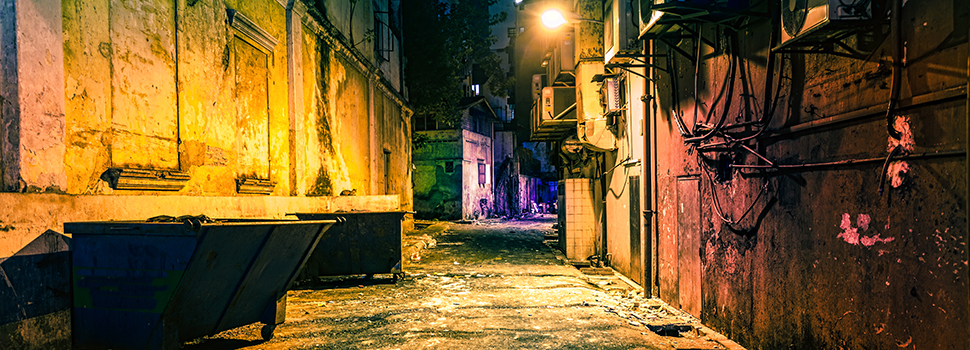Karen Quach | March 14, 2018
The Top 10 States Where a Dropped Call Could Get You Killed [New Report]

Whether you’re on the subway, walking around town, or sitting on your couch at home, you’ve likely experienced a cell phone dead zone where your call suddenly drops or you can’t access the internet.
If you’re out and about, you may be too far from a cell tower, or a building, tree, or another barrier could be interfering with your phone’s transmission signal. And if you’re sitting at home, there’s a chance a dense cloud is blocking your cell coverage or a high volume of users is accessing a particular cell tower, affecting your signal strength.
Dead zones are frustrating, but they can also be frightening if you can’t use your phone in an unfamiliar or high-crime area. Check out our new analysis on internet and cell connectivity in some of the most dangerous states in America, then zip to the end for tips on dealing with a dead zone.
The Deadliest Dead Zones, Ranked
Below, we’ve listed the 10 most dangerous states in America to be without internet or cell signal, in order from least to most risky. Be careful when exploring these areas and know that you may have trouble getting cell reception or accessing the internet in an emergency.
#10: Nevada
Connectivity: Nevada has the second-worst cell phone coverage on this list, and it falls behind the rest of the list by a margin of about 5 points—on a 10-point scale. That’s partly because so much of Nevada is un-populated, but that disclaimer doesn’t help if you live in a rural area or travel through one. That said, of the 10 states listed here, Nevada actually has the best high-speed internet connectivity, with only 6% of residents going without access.
Crime: Nevada is in the middle of the pack, coming in 5th for property crime, 6th for violent crime, and 5th for murder rate. While the risk is still there, it’s lower than others on this list.
#9: Florida
Connectivity: Florida has solid internet access and cell coverage. Only 7% of the population doesn’t have internet access at home, and the cell coverage score is 9.1 out of 10—the highest score on this list.
Crime: Florida is just above average for violent crime and murder rates. Its property crime rate index, however, is notably higher—56 against the national average of 38.1.
#8: Maryland
Connectivity: Maryland has the same high-speed internet access as Florida, with only 7% of people lacking access, plus the second-best cell coverage score on this list at 8.8.
Crime: Maryland comes in third for both property and violent crime rates. It takes last place for murder rate, but maybe that isn’t saying much for a list of some of the most dangerous states in the country.
#7: Georgia
Connectivity: Georgia has decent cell coverage and only 14% without high-speed internet access at home (compared to 40% in the least-covered state).
Crime: Georgia is the country’s second-most dangerous state for all three crime markers. Be careful there!
#6: New Mexico
Connectivity: New Mexico has even worse cell coverage (0.9 out of 10) than its desert brother Nevada, and it’s got low internet connectivity, too, with 30% of homes lacking access.
Crime: New Mexico has the third-lowest violent crime rate, the second-lowest property crime rate, and the lowest murder rate on this list. The rates are still above the national average, but the consequences of being disconnected may be lower than in other states mentioned here.

#5: South Carolina
Connectivity: About a quarter of South Carolinians (23%) don’t have internet at home, but the cell coverage score is decent at 8.7 out of 10.
Crime: South Carolina is on the high end of the violent crime index (56 to 31.1 national average) and murder rate (10 to 5.3 national average). The property crime rate index is a bit closer to average (38.1) at 48, but still higher. It’s worth noting that all the top five deadliest places to be stuck in a dead zone are in Southern states—and that’s not including Georgia and Florida in the top 10. Here’s hoping governments, businesses, and culture in the South can find more connectivity and crime solutions (’cause y’all deserve the best, too).
#4: Louisiana
Connectivity: Louisiana has a respectable cell coverage score of 8.5, but almost a third (29%) of the population goes without home internet access.
Crime: Louisiana has the lowest property crime index on this list (41 against the 38.1 national average), but violent crime is a different story. The state has a violent crime index of 47 against the 31.1 national average and the highest murder rate on this list—12.8 against the national average of 5.3.
#3: Texas
Connectivity: Texas has the second-worst internet access, with 38% of homes going without. Cell coverage is just under South Carolina and Louisiana at a score of 8.2 out of 10.
Crime: Texas has the lowest violent crime rate index on this list, but it’s still above average with 42 against the national average of 31.1. The property crime rate index is fairly high, with 47 to the 38.1 national average, and so is the murder rate, with 9.9 to the 5.3 national average.
#2: Mississippi
Connectivity: Mississippi has the worst internet access of them all—40% of households go without. At 7.9, the cell coverage score is far better than New Mexico’s or Nevada’s, but still lower than most states’.
Crime: Mississippi is up there for crime. It’s sixth highest in property crime, fifth highest in violent crime, and third highest for murder rate.
#1: Alabama
Connectivity: Alabama has the third-worst internet accessibility on the list, with over 35% of people lacking internet access at home. Alabama also has the third-worst cell score on this list, though at 7.8 it still has a considerable lead over New Mexico and Nevada.
Crime: Be careful in Alabama. It leads the country in property and violent crime, with an index of 68 to the 38.1 national property crime average and an index of 78 to the 31.1 national average for violent crime. Luckily, it’s not in first place for the murder rate—but unfortunately, it is still high with 10.4 compared to the 5.3 national average.
Methodology
These rankings are our best estimates of the relative risk associated with living or traveling in places with low connectivity and high crime rates. To calculate these results, we looked at the five factors below, which are listed in order from most to least weighted:
Home internet service
We looked at cities and states where internet service isn’t available or isn’t reliable, which can help with things like making Wi-Fi calls if cell signal is unavailable or unreliable. The FCC expresses internet availability as the percentage of households without home internet speeds of least 25 Mbps download and 3 Mbps upload.
Cell reliability score
We looked at cities and states that don’t have good cell phone reception—areas otherwise known as dead zones. Our source scored cell signal availability out of 10 points.
Property crime rate index
We compared cities, counties, and states with high property crime rankings compared to the national average of 38.1. Rankings, established by Sperling’s Best Place to Live, are expressed as a value on a scale of 100 with 100 being the place with the most instances of property crime.
Violent crime
We compared cities, counties, and states with high violent crime rankings compared to the national average of 31.1. Sperling expresses the ranking as a value on a scale of 100, with 100 representing the place with the most instances of violent crime.
Murder rate
We compared cities, counties, and states with high murder rates against the national average of 5.3, available from the FBI’s annual crime data report. The murder rate measures how many people are killed annually per 100,000 residents.
10 States with the Worst Connectivity and Highest Crime

Tips for Getting Reception in a Dead Zone
Knowing what states have high crime rates and dead zones can help you feel more confident and aware when you’re exploring the area—and learning new strategies for dealing with dead zones won’t hurt, either. If you live in or are visiting these 10 states, try a few of these tips to potentially boost your reception or gain internet access:
- Invest in high-speed internet. There’s always the possibility that your internet connection just isn’t fast enough to match your needs. Try switching to high-speed internet to see if that helps or solves the problem.
- Find higher ground. If you think a tree or building is blocking your signal, try to gain ground. Walk up to the top floor of your home or drive to a slightly higher elevation for a stronger signal.
- Get a cell phone or Wi-Fi signal booster. Many cell phone carriers and internet providers offer boosters that improve your cell signal or Wi-Fi connection. Pick either of these items and see how they enhance your phone’s ability to make calls, send texts, or connect to the web.
- Pull over or stand still for a minute. When you’re driving or walking, your phone has to keep adjusting for your location. Find a place to stop and give your phone a chance to get a signal.







